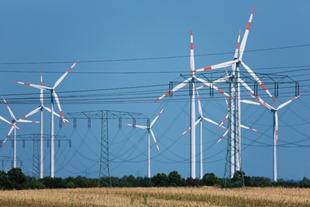Wind Power Technology; Thirty Years and Counting
by Kate Galbroith, NEW YORK TIMES, August 8, 2011
 The electric wind turbines built 30 years ago, after the 1970s oil-price shocks increased interest in the industry, often experienced serious problems. Some came apart in bad storms, some did not work well, even in good weather, and still others found insects piling up on the blades, slowing power production. Bird deaths at some early wind farms were alarmingly high.
The electric wind turbines built 30 years ago, after the 1970s oil-price shocks increased interest in the industry, often experienced serious problems. Some came apart in bad storms, some did not work well, even in good weather, and still others found insects piling up on the blades, slowing power production. Bird deaths at some early wind farms were alarmingly high.
Challenges remain, but the technology has come a long way in recent years, and wind farm operators have learned plenty of tricks, too, like the importance of shutting down the machines in high winds and the best places to put them to begin with.
The turbines have grown larger, and more effective. One model made today by Vestas, a Danish turbine manufacturer, can produce 300 times as much power as a turbine sold 15 years ago, according to Finn Strom Madsen, the president of technology research and development for Vestas.
But experts say that vast improvements in wind technology still lie ahead — which makes sense for an industry that is about 100 years behind, say, that of the automobile.
To date, many manufacturers have focused on making the machines bigger, so the towers can reach faster and steadier winds and the blades can cover a larger area. The biggest onshore turbine in Europe, according to Peter Sennekamp, a media officer with the European Wind Energy Association, is a 7.5-megawatt machine made by the German company Enercon.
It is 135 meters, or 440 feet, tall — one-third the height of the Empire State Building’s 102nd-floor observatory — and its three blades sweep an area 127 meters in diameter. The Enercon machine’s power potential dwarfs that of most turbines in the United States, where the average capacity is 1.77 megawatts, according to the American Wind Energy Association.
For wind companies, buying larger turbines (as opposed to putting up more of them) makes sense because it reduces overall transportation, logistical and operational costs, said Dan Radomski, co-founder of Kinetik Partners, a company that advises companies in the clean-energy sector.
But turbines destined for onshore wind farms may not keep getting bigger as quickly as they have in the past, experts say, because of logistical hurdles. As towers get to be 100 meters high and more, and blade length increases, shipping them gets challenging. Trucks carrying big towers and blades must sometimes move with police escorts and avoid certain overpasses or small roads.
(One potential solution is for blades to arrive in segments and be assembled on site; the tubular towers are already shipped in several sections, but even they face limits because taller towers generally need very thick foundations.)
Mr. Madsen, of Vestas, said that offshore turbines — less encumbered by roads and bridges — will keep growing more rapidly than their onshore counterparts.
Earlier this year, Vestas unveiled its plans for a seven-megawatt offshore machine, with a rotor diameter (the diameter of the area swept by the blades) of 164 meters. A March report, “Upwind: Design Limits and Solutions for Very Large Wind Turbines,” prepared with support from the European Commission, found that a 20-megawatt turbine — with each blade probably more than 120 meters long — was “feasible.”
But sheer size is not the only way that turbines will improve. Research and development work has proliferated around matters like how to pitch, or angle, the blades and how to monitor wind speed and direction at a turbine more accurately, using lasers.
“This is probably the most exciting time in the industry as far as companies launching new product platforms,” Mr. Radomski said, adding that much of the research and development work was happening in Europe, where the modern wind industry grew up. [Read rest of article]


